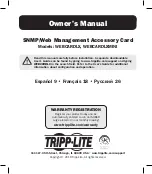
CHAPTER 13: RAPID SPANNING TREE PROTOCOL
RAPID SPANNING TREE PROTOCOL
MULTILINK ML2400 ETHERNET COMMUNICATIONS SWITCH – INSTRUCTION MANUAL
13–19
The port specific values for RSTP or STP are shown below.
Z
Click on the edit icon (
) to edit the values for a specific port.
The columns in the above window are defined as follows:
•
Port#
: Indicates the port number. Value ranges from 1 to the maximum number of
ports in the switch.
•
Port Type
: Indicates the type of port and speed; TP indicates twisted-pair.
•
Port State
: Forwarding implies traffic is forwarded onto the next switch or device
connected the port. Disabled implies that the port may be turned off or the device
connected to it may be unplugged or turned off. Values can be Listening, Learning,
Forwarding, Blocking and Disabled.
•
Path Cost
: This is the assigned port cost value used for the switch to determine the
forwarding points. Values range from 1 to 2000000. The lower the value, the lower
the cost and hence the preferred route. The costs for different Ethernet speeds are
shown below. The STP path cost is compared to the RSTP path cost.
•
Priority
: STP uses this to determine which ports are used for forwarding. Lower the
number means higher priority. Value ranges from 0 to 255. Default is 128
•
Edge Ports
: RSTP offers edge port recognition, allowing ports at the edge of the
network to forward frames immediately after activation while at the same time
protecting them against loops.
Table 13–2: Path cost defined in IEEE 802.1d and 802.1w
Port Type
STP Path cost
RSTP Path cost
10 Mbps
100
2 000 000
100 Mbps
19
200 000
1 Gbps
4
20 000
10 Gbps
2
2000
















































